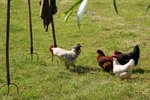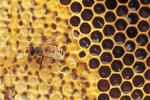
Hummingbirds feed frequently and protect their food sources fiercely. In the wild, their diet is 90 percent flower nectar, according to the National Audubon Society website. Many hummingbirds make long migration flights and have to double their weight before departure. Whether the hummers near your home live there year-round or pass through annually, understanding their nutrient requirements helps you provide safe and healthy hummingbird food.
Metabolism
These relatively small birds have extremely fast metabolisms. They lose heat quickly because of their small size and their rapid wing beats. Heat loss and exertion burn calories. In the fall, calorie needs of migratory hummingbirds increase. For example, the rufous hummingbird flies from breeding areas in Alaska through northern California to winter in central Mexico. Gaining weight before migration gives the birds enough fuel to survive the flight. Hummingbirds adjust the size of their territories based on the amount of food available, and they conserve energy by perching when they don't need to defend their territory or feed.
Nectar
Hummingbirds specialize in pollinating nectar-producing flowers. Red flowers with deep throats tend to attract hummingbirds. Bright pink, purple, blue, orange and yellow flowers attract them, too, such as trumpet vine and petunias. When they feed on a flower, they pick up pollen and deliver it to other flowers, helping the plant reproduce. They prefer nectar rich in sucrose to those containing glucose or fructose, the other sugars common in flower nectar, the Smithsonian National Zoological Park reports. The common hummingbird feeder recipe of one cup of table sugar to four cups of water provides hummingbirds with the right concentration of sucrose.
Insects
Although feeding on nectar gives hummingbirds energy for their rapid flight and hovering, they need protein, too. Pollen from the flowers they feed on provides some of their protein. Insects and spiders serve as their main protein sources. The birds will eat spiders and insects caught in a spider's web. They also pluck insects out of the air or off plants. Mother hummingbirds feed insects to their young because the growing birds need a diet high in protein.
Considerations
Don't add food coloring or commercial hummingbird food made with dye to hummingbird food because it may harm the birds, the Cornell Lab of Ornithology advises. Honey isn't suitable for hummingbird food, because bacteria and fungus thrive in honey diluted with water. The best places for hummingbird feeders are shady spots out of reach of cats. Sunlight can cause sugar-water to ferment and spoil. If possible, supply hummingbirds with native plants such as bee balm, hummingbird sage and trumpet honeysuckle. The native versions have more nectar than hybrids, according to Audubon. Flower nectar supplies micro-nutrients. If you don't have space for a hummingbird garden, many hummingbird-attracting plants grow well in window boxes or containers.
References
- Audubon: Hummingbirds / Nectar Feeders
- Smithsonian National Zoological Park: Rufous Hummingbird -- The Hummingbird Diet: How to Gain Weight and Keep It
- Smithsonian National Zoological Park: Ruby-throated Hummingbird -- Flower Specialist
- Cornell Lab of Ornithology: Not all Sweetness and Light
- Cornell Lab of Ornithology: Feeding Hummingbirds
- Audubon: Hummingbird-healthy Habitats
Resources
Photo Credits
-
NA/Photos.com/Getty Images
Writer Bio
Gryphon Adams began publishing in 1985. He contributed to the "San Francisco Chronicle" and "Dark Voices." Adams writes about a variety of topics, including teaching, floral design, landscaping and home furnishings. Adams is a certified health educator and a massage practitioner. He received his Master of Fine Arts at San Francisco State University.




